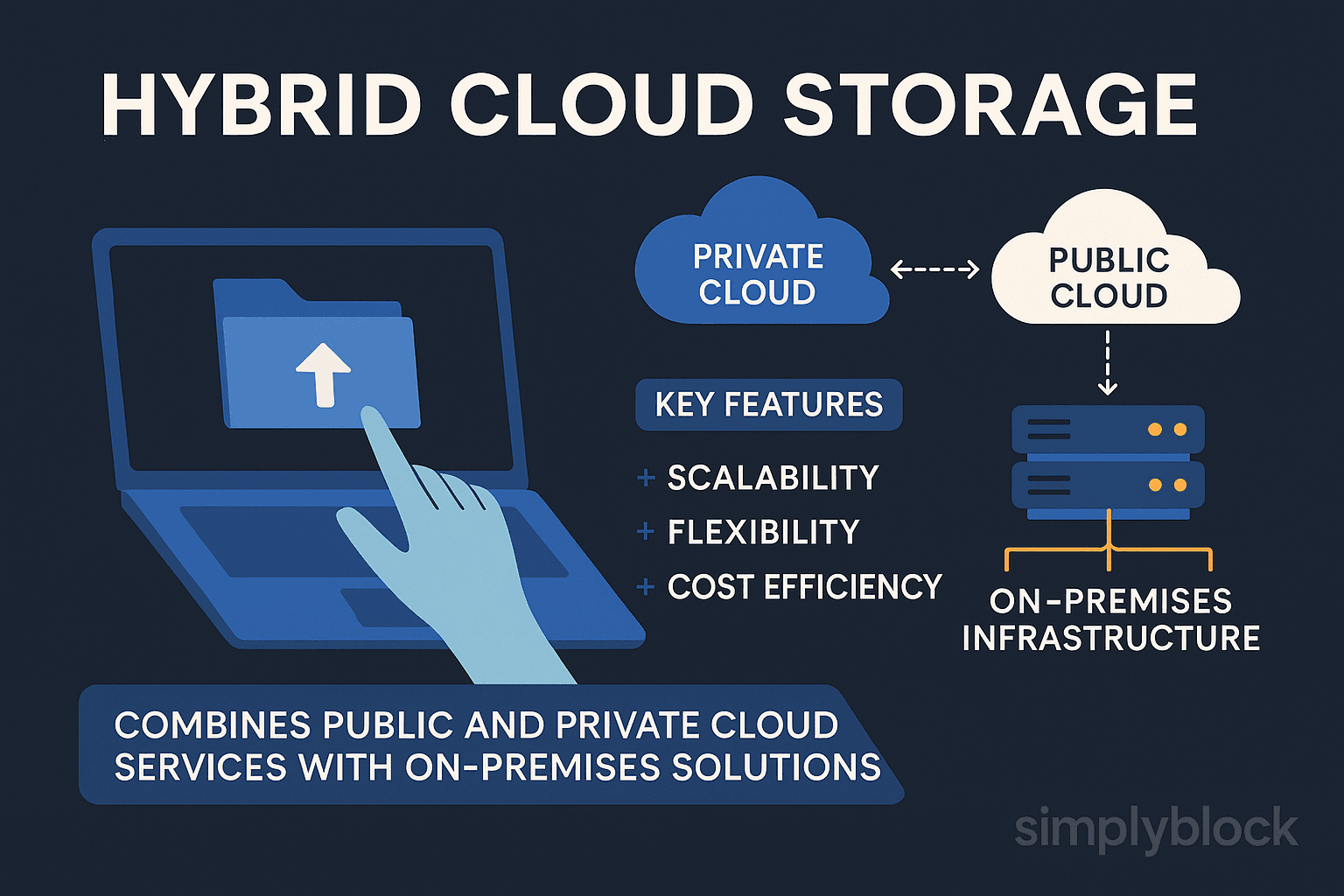Hybrid Cloud Storage
Terms related to simplyblock
Hybrid cloud storage is a data storage architecture that combines on-premises infrastructure with public or private cloud storage. It enables organizations to store, manage, and move data across local data centers, edge environments, and hyperscaler platforms like AWS, Azure, or GCP—based on performance, cost, compliance, or locality needs.
The hybrid model provides flexibility to optimize for both latency-sensitive applications and long-term archival storage, while retaining control over data placement. Platforms like simplyblock extend software-defined storage capabilities across hybrid deployments using NVMe-over-TCP, CSI integration, and multi-zone replication.
How Hybrid Cloud Storage Works
In a hybrid model, different workloads or tiers of data are distributed across environments:
- Hot data (frequently accessed): resides on fast local NVMe storage
- Warm/cold data: migrated to cloud object storage for cost savings
- Replication and backup: done across both local and cloud targets
Hybrid storage can be managed via centralized orchestration, using storage APIs or software-defined platforms that abstract physical location from access logic. simplyblock, for example, uses a single control plane to deliver consistent volumes across cloud, edge, and on-prem nodes.
Benefits of Hybrid Cloud Storage
Hybrid storage is designed for organizations that want cloud agility without giving up local control. Key benefits include:
- Data locality control: Keep sensitive or high-performance data on-prem, while leveraging the cloud for scale or redundancy.
- Cost optimization: Store archival or infrequently accessed data in low-cost cloud tiers like S3 Glacier.
- Disaster recovery: Replicate data across regions to ensure business continuity.
- Burst scalability: Handle seasonal or sudden traffic spikes by scaling into cloud storage.
- Kubernetes-native workflows: Run persistent stateful workloads across hybrid clusters using CSI-based provisioning.

Use Cases for Hybrid Cloud Storage
Hybrid storage supports both legacy systems and modern, cloud-native workloads. Common use cases include:
- Edge-to-cloud analytics: Collect and process data locally, then push to the cloud for AI/ML workloads.
- Kubernetes on hybrid infrastructure: Unified volume provisioning across on-prem and cloud clusters.
- Data archiving and compliance: Keep recent records locally and archive older ones in immutable cloud storage.
- Cloud migration: Gradual movement of apps and data without service disruption.
- Multi-site database clusters: Synchronize volumes across data centers and cloud zones.
Hybrid vs Public vs Private Cloud Storage
Each storage model offers distinct benefits depending on operational goals. Here’s how they compare:
| Feature | Hybrid Cloud Storage | Public Cloud Storage | Private Cloud Storage |
|---|---|---|---|
| Deployment Scope | On-prem + cloud | Fully cloud-hosted | On-premise or dedicated host |
| Flexibility | High | Moderate | Low |
| Cost Optimization | Optimized per workload | Pay-as-you-go | Fixed CapEx |
| Data Locality | Customizable | Cloud-region dependent | Full control |
| Latency | Low for hot data | Varies by region | Consistent |
| Ideal Use Case | Cloud-native + legacy workloads | Cloud-first apps | Regulated industries |
Simplyblock™ for Hybrid Cloud Storage
Simplyblock delivers high-performance hybrid cloud block storage via:
- NVMe-over-TCP transport for low-latency access from on-prem and cloud nodes
- CSI-based dynamic provisioning across Kubernetes clusters
- Erasure coding for cross-site data durability
- Support for multi-tenancy and QoS in hybrid environments
- Unified control plane for hybrid and air-gapped storage
It bridges performance workloads on-prem with cloud-native scalability, ideal for modern enterprises running across multiple locations.
External Resources
- Hybrid Cloud Storage Explained – IBM
- Hybrid Cloud Strategy – Microsoft Azure
- Amazon S3 Storage Classes
- Kubernetes Storage Concepts – Official Docs
- Google Cloud Hybrid Architectures
Questions and Answers
Hybrid cloud storage combines on-prem and cloud resources, offering flexibility, cost control, and data locality. It allows businesses to keep sensitive data on-site while offloading backups or overflow to the cloud, making it ideal for regulatory and performance-sensitive environments.
Hybrid storage setups can provide persistent volumes for Kubernetes by integrating on-prem NVMe storage with cloud-based object or block storage. This ensures fast local performance while enabling scalable backup and disaster recovery in the cloud.
Hybrid storage offers better performance, lower latency for local workloads, and improved data control. It can also reduce cloud costs by using storage tiering strategies that move cold data to cheaper cloud storage while keeping hot data on fast local volumes.
Yes. Secure hybrid environments use encryption at rest across both cloud and on-prem storage, ensuring compliance with data protection regulations like GDPR or HIPAA in multi-tenant and regulated industries.
Absolutely. NVMe over TCP enables disaggregated storage over standard Ethernet, making it possible to integrate high-speed on-prem storage into hybrid environments without proprietary hardware dependencies.
